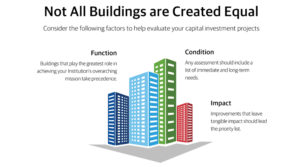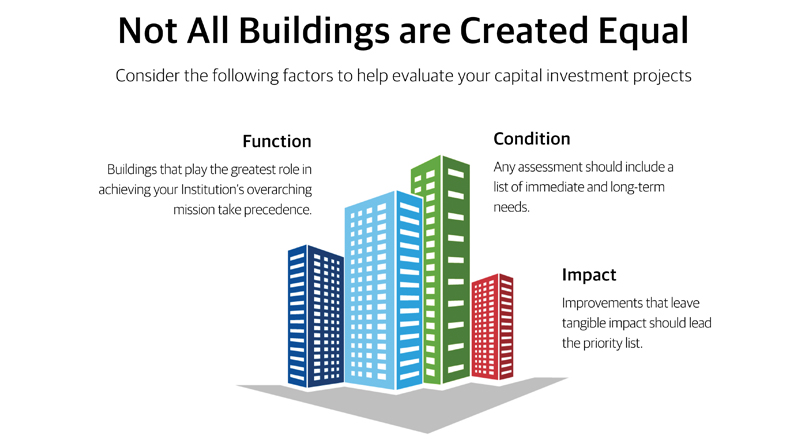How to Reduce Excessive Deferred Maintenance
By Jay Pearlman
Deferred maintenance is a challenge plaguing many colleges and universities around the country. As funding tightens, the facilities department is typically among the first required to make do with less funding. This is in part because the facilities department needs are often less visible than the competing needs of faculty salaries and financial aid. However, putting off necessary maintenance today ultimately leads to more severe — and more expensive — problems tomorrow that could impact a facility’s ability to effectively compete.
A maintenance backlog can seem overwhelming when approached as a whole, particularly if the maintenance has been deferred for some time. But when facilities managers categorize their projects, they can create a prioritization system that helps them to balance the various needs, and budgets, of different projects. You can prioritize projects by putting each into one of three categories that indicates the level of damage caused by deferred maintenance. This system also benefits facilities managers who must make an easily digestible case to those financial stakeholders who will make the ultimate decision about whether or not to invest in maintenance projects.

Photo Credit: Sightlines
Shifting from New to Existing Facilities
Until recently, many higher-education institutions have focused their attention primarily on adding new facilities to their campuses. These institutions have viewed adding buildings designed to meet the latest expectations as the most visible way to attract leading faculty and the brightest students. However, this investment often comes at the expense of existing buildings. This can be especially problematic when the school leadership doesn’t take into account the long-term maintenance investment that will be necessary to support their new facilities, on top of existing maintenance needs.
There are two types of costs associated with maintenance, both of which must be considered.
• Keep-up costs: Describes the ongoing annual investments necessary to keep buildings performing properly and able to perform during their full useful life.
• Catch-up costs: Describes those charges that come as a result of the accumulation of repair projects that have been deferred as well as any modernization improvements necessary for the facility to perform competitively.
When new construction is prioritized over maintenance for improvements to existing buildings, catch-up costs often grow unwieldy. At some point, however, these costs must be addressed in order to prevent a significant breakdown.
The alternative is to wait until systems suffer a catastrophic failure, at which point the expense and frequency of emergency repair costs will grow far beyond the budget you can plan for today.
Classifying your projects according to these costs will help in your prioritization of capital investments. But there are other factors you can use to prioritize the greatest need for maintenance attention.
3 Criteria for Evaluations
Not all buildings or building needs are equal. And this is a good thing, as presenting financial decision-makers with an overwhelming list of project needs, rather than a clearly prioritized list of items to address over time, is a surefire way to cut short the funding conversation. Consider the following three factors to help evaluate your projects and determine how quickly their needs must be addressed:
1. Condition: The degree of impact the deferred maintenance has had on the overall performance of a facility will of course be the most pressing concern. Some facilities will show immediate need for refurbishment, while others may be able to continue operating for several more years with only moderate upkeep. Others may be ready for tear down to make way for new construction. An assessment should include details about how well the building is performing and list its most immediate and long-term needs.
2. Function: Those buildings that play the greatest role in helping an institution achieve its overarching mission should take a lead on the list of facilities in need of maintenance. Consider whether or not a proposed project supports the institution’s goals and/or improves its financial performance. If the answer is yes, then this is a high-priority project.
3. Impact of Improvements: Will proposed improvements be visible to staff or students? Will they present savings that in some way reduce spending? Maintenance improvements that are likely to leave a tangible impact should lead on your priority list.
By determining which projects meet one or more of the criteria above, facility managers can begin to put in place a plan that will, over time, demonstrate a clear path to campus improvement.
To read the entire article, check out the July/August issue of School Construction News.
Jay Pearlman is associate vice president, marketing, at Guilford, Conn.-based Sightlines, an expert on facility planning.

